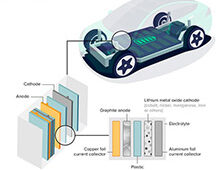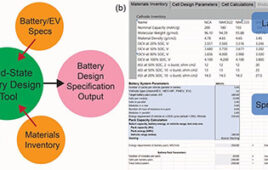
Caption: Researchers have discovered a new material that could lead to a new generation of lithium-ion batteries.
A tiny nanocluster may help enable the faster, smaller and more stable batteries needed for modern devices.
Researchers from the University of Illinois at Urbana-Champaign have developed a superionic solid that could lead to the next-generation of lithium-ion batteries.
Chemistry professor Prashant Jain and graduate students Sarah White and Progna Banerjee have described the material as ultrasmall nanoclusters of copper selenide.
“Now that we’re seeing this nanoelectronics boom, we need tiny batteries that can be put on a chip, and that can’t happen with liquid electrolytes,” Jain said in a statement. “We are using nanostructured materials to achieve the properties at the heart of lithium-ion technology.
“They have much more thermal and mechanical stability, there are no leakage issues and we can make extremely thin electrolyte layers so we can miniaturize batteries,” he added.
Standard lithium-ion and other ionic batteries are filled with a liquid electrolyte that the lithium ions move through.
The ions flow in one direction when the battery is being used and in the opposite direction when the battery is charged.
However, liquid electrolytes require volume, degrade as the battery cycles, leak and are highly flammable, which has led to explosions in phones, laptops and other devices.
Solid electrolytes are seen as more stable, allowing the ions to move through them much slower, which makes them less efficient for battery applications.
The new copper selenide nanocluster electrolyte features the stability of a solid electrolyte, but allows the ions to easily move through it like a liquid.
The material is known to be superionic at high temperatures but the tiny nanoclusters are the first demonstration of the material being superionic at room temperature.
“Here we show that ultrasmall clusters of copper selenide exhibit a disordered cationic sub-lattice under ambient conditions unlike larger nanocrystals, where Cu+ ions and vacancies form an ordered super-structure similar to the bulk solid,” according to the study.
The researchers first noticed the nanoclusters while investigating copper selenide’s surface reactivity.
“That was our first hint that they have different structures,” Jain said. “We investigated further, and we realized that these small clusters are actually semiliquid at room temperature.”
According to Jain, the reason for the semiliquid, superionic property is the special structure of the nanoclusters where the much larger selenium ions form a crystal lattice, while the smaller copper ions move around them like a liquid.
“With around 100 atoms, these nanoclusters are right at the interface of molecules and nanoparticles,” Jain said. “Right now, the big push is to make every nanoparticle in a sample exactly the same size and shape.
“It turns out with these clusters, every single cluster is exactly the same structure,” he added. “Somehow, at this size, the electronic structure of the material is so stable that every single cluster has the same arrangement of atoms.”
The researchers are now working to incorporate the nanoclusters into a battery, measure the conductivity of lithium ions and compare the performance with existing solid-state electrolytes and liquid electrolytes.
The study was published in Nature Communications.




